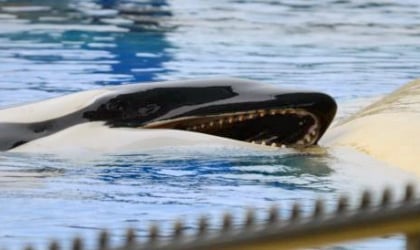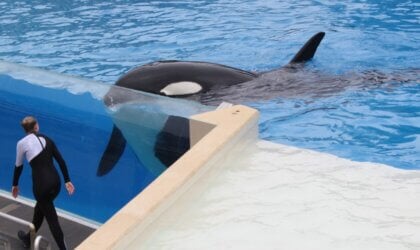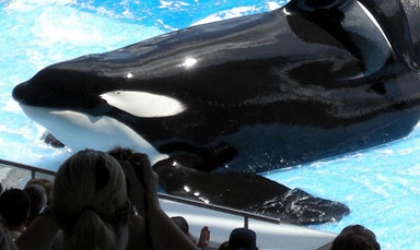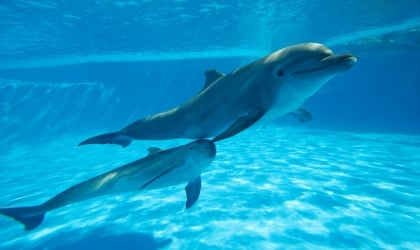Orca Kasatka is dead at SeaWorld, the third orca and sixth marine mammal to die at one of its parks this year.
According to reports, Kasatka had been suffering from a bacterial lung infection since at least 2008 and her ailing body was covered in lesions before her death. Even though she was sick and on medication, SeaWorld artificially inseminated Kasatka again in 2011 and forced her to bear a fourth calf for the parks to exploit.
Former SeaWorld trainer John Hargrove told Dolphin Project, that “[h]istorically, when a necropsy is performed on an animal with this level of fungal infection, the fungal lesions are far worse internally than they are externally. It is also an incredibly painful way to die.”
This June, he told the Times of San Diego that he believed that SeaWorld was likely “doing everything known to science to keep her alive” so that Kasatka would not become the third orca to die at the parks this year. SeaWorld let her suffer until, finally, last night, the company euthanized her. She’s the 41st orca to die on SeaWorld’s watch—and not one died of old age. In death, she’s finally free.
No orca should ever have to live and die in a barren concrete cell for SeaWorld’s profits and humans’ fleeting amusement. Read Kasatka’s sad story below, and demand that SeaWorld release the remaining captive orcas to sea sanctuaries today.
The following was originally published on July 19, 2017:
Kasatka was abducted from her family and robbed of any semblance of a natural life when she was just 1 year old. Since then, she’s been held captive at various SeaWorld parks and, in recent years, has been showing signs of severe illness and infection, a contributing factor in more than half of the orca deaths at SeaWorld’s parks, according to a San Antonio Express-News investigation.
Exclusive: Is SeaWorld's Orca Kasatka Losing Her Battle with Chronic Illness? https://t.co/OXb74R1MS0 #DolphinProject pic.twitter.com/tjkYOtx2O5
— Dolphin Project (@Dolphin_Project) June 17, 2017
In light of recent reports that indicate that Kasatka could be near death, we’re detailing the orca’s tragic story and calling on SeaWorld to end decades of orca mistreatment now.
Early Life
In 1978, she was captured in Iceland alongside her pod-mate Katina, who was 2 years old, and they were sold to SeaWorld that same month. For four years, they lived together, but the two were separated in 1984 when Katina was shipped to SeaWorld Orlando, where she remains imprisoned today.

Kasatka has now been imprisoned at SeaWorld for nearly four decades and has been forced to perform in as many as eight shows a day. Although she’s served most of her sentence at SeaWorld San Diego, she’s spent parts of it at each of the four SeaWorld parks—including the now-defunct SeaWorld Ohio—being transferred between the abusement parks 14 times in just eight years.
Children, Grandchildren, and Great-Grandchildren
Kasatka has been bred numerous times since being purchased by SeaWorld. She’s given birth to four calves and is a grandmother or great-grandmother to eight other orcas, according to the Times of San Diego.
She gave birth to her first calf, Takara, on July 9, 1991. Her mate and Takara’s father, Kotar, died when the calf was only 3 years old, after a pool gate closed on his head, fracturing his skull. Even though wild orcas often live with their mothers for life, Kasatka and her daughter were separated when Takara was only 12 years old.
Orca Takara's story of life in a tiny #SeaWorld tank is so wrong She & her baby deserve to go to a sanctuary! pic.twitter.com/qAzad6DyPi
— PETA (@peta) April 12, 2017
In 2001, Kasatka gave birth to Nakai, the first calf to be born via rape with Tilikum’s sperm—even though Tilikum had already killed two people and Kasatka had a history of aggression toward trainers. In spite of Kasatka’s fierce attempts to protect her baby, Nakai was kept in a tiny concrete tank with incompatible orcas and, in 2012, lost a large chunk of his jaw after being attacked by two other orcas.
https://www.instagram.com/p/QVhEYYG-OB/
In 2002, Kasatka’s daughter Takara gave birth to her first calf, Kohana, as a result of rape via artificial insemination, also with the sperm of Tilikum. She was only 10 years old when she gave birth, despite scientific studies showing that, in the wild, the average age at which female orcas begin to reproduce is 14.9.

Takara with one of her calves
Kasatka lived with Takara and Kohana for the next two years before her daughter and granddaughter were separated from her and sent to Florida. Soon after, Takara had her second calf, Trua. A few months later, the 3-year-old Kohana was taken away from Takara and sent to Loro Parque in Spain, where—without the protection of her mother—she was impregnated twice by her uncle Keto, the first time when she was just 7 years old. Never having learned how to mother, Kohana rejected Adan and Victoria, her two inbred calves, and Victoria died within a year.

On December 21, 2004, Kasatka gave birth to Kalia after mating with Keet. Kalia was later raped via artificial insemination at the age of 8, as well as allowed to mate with the much older Ulises when she was very young, giving birth to Amaya.
BREAKING:
Kalia (orca at @SeaWorld) is pregnant. Sad that her baby won't get 2 swim in the ocean.
RT if u agree! pic.twitter.com/yvBVLguoks
— PETA (@peta) April 21, 2014
On Valentine’s Day 2013, Kasatka gave birth to Makani after being raped via artificial insemination with the semen of Kshamenk—one of the loneliest orcas in the world—who lives alone at the Argentinean marine park Mundo Marino.
Learn more about SeaWorld on The PETA Podcast:
Listen to more episodes on iTunes, Stitcher, and Spotify! Subscribe for new episodes.
On March 17, 2016, SeaWorld announced that Kasatka’s daughter Takara was pregnant with her fifth baby. Takara gave birth to a daughter, Kyara, in April 2017. On July 24, 2017, SeaWorld announced that 3-month-old Kyara was dead. The news came after the park had announced only a few days prior that Kyara had an infection, likely pneumonia. Like so many captive orcas before her, Kyara died without the comfort of her mother, grandmother, or other family.
Takara is about to give birth to the last calf ever to be born at #SeaWorld. But ending orca breeding isn't enough. https://t.co/ZRFG7OvGIX
— PETA (@peta) February 23, 2017
Increased Attacks and Aggression
After giving birth to Takara in 1991, Kasatka proved to be a fiercely protective mother, and aggressive incidents increased, especially around her young.

Takara
According to David Kirby’s Death at SeaWorld, “Sometimes when Takara called for her mother, Kasatka would split from the trainer’s control to spend time with her calf at the gate, or swim in angry circles around the pool until finally responding to a call-back signal to the stage. Kasatka grew more aggressive with trainers in the water after Takara was born.”
In June 1999, she attacked her trainer Ken Peters after Takara unexpectedly left the main pool and entered a back tank. She circled Peters at high speed and then charged him with jaws wide, but he was pulled from the tank before she could grab him.
Her aggression toward trainers seemed to soar to new heights in 2004 after she gave birth to Kalia. In 2006, after hearing her baby crying in a back pool, Kasatka attacked Peters again, this time during a performance. She bit his legs, dragged him underwater, and put her weight on top of him—all 5,000 pounds. Frustrated with her captivity and fiercely protective of her calves, this was the third time that she attacked Peters. The California Division of Occupational Health and Safety (Cal/OSHA) took notice, issuing the warning that “if someone hasn’t been killed already, it is only a matter of time before it does happen.”
Illness and Infection
On August 1, 2016, SeaWorld announced that Kasatka had been receiving treatment for a bacterial respiratory infection for several years. Blaming her immune system and age—even though wild orcas can live to be more than 100 years old—SeaWorld also revealed that she’s now having more trouble fighting off the illness, as the medication has less of an effect.
According to reports, SeaWorld began treating her in 2008. This means that in 2011, when she was artificially inseminated, SeaWorld was knowingly and intentionally impregnating her while she was sick and likely receiving medication. Former SeaWorld trainer John Hargrove says this admission not only reveals that SeaWorld forced her to endure a 17-18 month gestation despite her illness, but that all of the drugs she was on must have been passed to her baby during the 1-2 years of nursing.
@SeaWorld U just admitted to breeding Kasatka when U knew she was sick. Disgusting display of greed over empathy. https://t.co/CyS4LepAAg pic.twitter.com/qeFucBonQa
— Dr Ingrid N. Visser (PhD) (@OrcaIngrid) June 20, 2017
Many have alluded to the possibility that SeaWorld is downplaying Kasatka’s illness. Hargrove has indicated that what SeaWorld refers to as injuries may actually be lesions caused by a fungal infection. Hargrove told Dolphin Project that “[c]aptive orcas are regularly treated for persistent fungal infections. The severity of this fungal infection demonstrates the diminished capacity of Kasatka’s own immune system … Sadly, when I look at this photo, all I see is a diseased whale. Historically, when a necropsy is performed on an animal with this level of fungal infection, the fungal lesions are far worse internally than they are externally. It is also an incredibly painful way to die.”
https://twitter.com/johnjhargrove/status/879377326840139776
Dr. Jeffrey Ventre, also a former SeaWorld trainer, said, “When I saw the image of her today, as a physician, it immediately reminded me of end stage AIDS. She is so immuno-compromised, covered in fungus, it’s clear that she is near death. I hope she passes quickly. The video sequence of her throttling Ken Peters, as seen in the ‘Blackfish’ movie, is the most shocking human–orca encounter ever seen, including with wild whales, in my opinion.”
This is breaking although Kasatka has been ill 4 a while. Based on what I saw, she looked like an end stage AIDs victim, fungus everywhere
— Jeffrey Ventre (@jeffrey_ventre) June 17, 2017
What You Can Do
An early, miserable death is the fate of captive orcas. It may be too late for Kasatka, but it’s not too late for SeaWorld to start building sea sanctuaries for the other orcas trapped in its tiny tanks, including Kasatka’s children and grandchildren. The decades of orca torment must end now.
It’s time for #SeaWorld to follow in the footsteps of #RinglingBros. [Art by @AndyMarlette] pic.twitter.com/DOOTEVxUl7
— PETA (@peta) January 22, 2017
You can help all the animals imprisoned by SeaWorld today. Click the button below to ask the company to end all animal acts at its parks and release the animals into sea sanctuaries.




